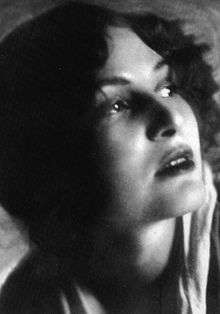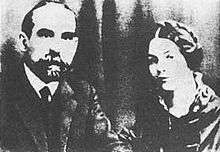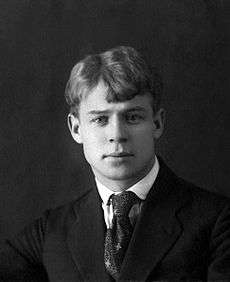Zinaida Reich
| Zinaida Reich | |
|---|---|
 | |
| Born |
Zinaida Nikolayevna Reich 3 July 1894 Odessa, Russian Empire |
| Died |
15 July 1939 (aged 45) Moscow, Russian SFSR, Soviet Union |
| Occupation | Actress |
| Spouse(s) |
|
| Children |
|
| Parent(s) |
|
Zinaida Nikolayevna Reich (the last name also spelled Raikh or Raih; Russian: Зинаида Николаевна Райх; 3 July [O.S. 21 June] 1894 – 15 July 1939)[1] was a Russian actress and became one of the main stars of the Meyerhold Theatre until it was closed under Joseph Stalin.
Reich married poet Sergey Yesenin and had two children with him. After their divorce, she married the director Vsevolod Meyerhold. In 1939 Meyerhold was arrested by the NKVD, and she was brutally stabbed in her apartment by NKVD agents who staged a robbery [2]
Family and early years

Zinaida Nikolayevna Reich was born in the village of Blizhniye Melnitsy near Odessa.[3]
Her mother was Anna Ivanovna Viktorova, a Russian noblewoman and niece of a notable Russian linguist and archaeologist, Alexey Viktorov (Викторов, Алексей Егорович).[1] Her father was of German descent, Augustus Reich, who worked as a sailor and a railroad engineer.[1] In order to marry Anna, Augustus Reich (originally a Roman Catholic) accepted Orthodox Christianity and was baptised as Nikolay Andreyevich Reich.[1] Augustus Reich was an early social democrat and had been twice politically exiled to the North of Russia prior to meeting Anna. As he continued his activity, during the Russian Revolution of 1905, the family was exiled from Odessa to Bendery.[1]
Zinaida Reich studied in a gymnasium in Bendery but was expelled for her political activities before completing the eighth (last) grade.[4] She enrolled in the Kiev Higher Education Courses for Women, and in 1913 she became a member of the Socialist-Revolutionary Party.[5]
She worked as a technical editor for Delo Naroda (People's Cause), a newspaper of the Socialist-Revolutionary Party. There she met the poet Sergey Yesenin, who at that time was influenced by the Party. Yesenin settled in Saint Petersburg in March 1917.[4]
Marriage to Sergey Yesenin

In spring 1917 Reich met Sergey Yesenin. The young people fell in love. They traveled to the White Sea and Russian North and got married in Kiriko-Ulitovskaya Church near Vologda on 4 August 1917. After the wedding, the couple moved to Oryol, where her parents lived.[1][4]
In September 1917 the couple returned to Saint Petersburg, where Reich worked for the People's Commissariat for Food (NarkomProd). In 1918 the People's Commissariat moved to Moscow and so did the couple. As Zinaida was pregnant, she moved to be with her parents in Oryol while Yesenin continued his literary career in Moscow.[4]
Reich returned to Moscow when their daughter, Tatiana, was one year old, but she and Yesenin quarreled. In February 1920 Reich gave birth to their son Konstantin, but the couple continued to live separately. At that time Reich lived in a shelter for mothers with infants. On 5 October 1921 Zinaida Reich and Sergey Yesenin were officially divorced.[4]

The story of the couple is known from the memoir Novel without Lies (1926)[6] (Роман без вранья) written by Yesenin's close friend, room-mate and allegedly homosexual lover[7][8] Anatoly Marienhof. Marienhof described Reich as a "crummy Jewish dame with fleshy lips on a face round as a dinner-plate". He wrote that Yesenin allegedly was upset when he saw his black-haired son, Konstantin. "No Yesenin had ever been black-haired", he allegedly said.[6] Reich had dark hair, which is genetically dominant over light hair.[9] Historians have doubted that Marienhof's description of Reich is accurate. She was of German-Russian ancestry and Russian Orthodox by faith.
Marriage to Meyerhold
Reich studied at the State Experimental Theatre Workshops, headed by famous theatrical director Vsevolod Meyerhold.[4] Meyerhold was 20 years older than she; at the time he had been married for 25 years to his wife Olga and had three daughters with her.[3] He ended up getting a divorce, and Reich and Meyerhold married in 1922.[5]
Yesenin and Reich had a relationship after her second marriage. The poet often broke into the house of Meyerholds demanding to see his former wife and children. Reich and Yesenin met secretly in her friend's apartment.[4] Yesenin committed suicide on 23 December 1925.
Star of Meyerhold Theater
Reich worked as an actress and was featured as a star of the Meyerhold Theatre from 1923 until her death in 1939. According to the theatre critic N. Volkov:

The works of Vsevolod Meyerhold of the 1920s and 1930s cannot be understood without Zinaida Reich ... In all his productions, Meyerhold was building 'mise en scenes' to feature Zinaida Reich ... If he was afraid that Zinaida would not manage her part, he would create beneficial 'mise en scenes' for her... Together with Meyerhold, Reich traveled his creative path: from experiments in biomechanics to deeper psychologism".[5]).
Meyerhold took the family name Meyerhold-Reich as a sign of their partnership.[4]
Not everyone accepted that a young actress with no experience had become the star of the famous theatre. According to Anatoly Marienhof, when Meyerhold had suggested that he would make Reich a great actress, Marienhof said he might as well invent electric lamps. Marienhof wrote that one needed no talent to become a famous actress – only Meyerhold as the husband and idiots as the public.[10] The actor Igor Ilyinsky was so upset that Reich received all the major roles that he left the Meyerhold Theater. Later, he revised his opinion of her acting talent and appreciated her.[5]
Murder
In the early 1930s, as Stalin repressed all avant-garde art and experimentation, the government declared Meyerhold's work as antagonistic and alien to the Soviet people. His theatre was closed down in January 1938. The ailing Constantin Stanislavski, then the director of an opera theatre (now known as Stanislavsky and Nemirovich-Danchenko Music Theatre), invited Meyerhold to lead his company.
Stanislavski died in August 1938. Meyerhold directed his theatre for nearly a year until he was arrested in Leningrad on June 20, 1939. Twenty-five days later, his wife Zinaida Reich was found dying in their Moscow apartment on 15 July 1939.[11] Two unknown assailants broke into the Reich-Meyerhold apartment during the night of 14–15 July. They stabbed her 17 times, including through the eyes. She died of exsanguination early the next morning, 15 July. Reich had sent both her children out of the apartment that night, and nothing was taken from the apartment. The murder is generally regarded as having been organized by the NKVD.[12][13][14][15] According to Arkadiy Vaksberg, "Beria needed this sadistic farce" because the actress was extraordinary popular, independent, outspoken and known for saying: "if Stalin can make no sense of art, let him ask Meyerhold, and he will explain"[16]
Zinaida Reich was buried at Vagankovo Cemetery near the grave of her first husband, Sergey Yesenin.[13] As Meyerhold was executed by the NKVD on 2 February 1940 after a confession from torture, the location of his remains is not known. Supporters erected a memorial to him at Reich's gravesite.[17]
Her Moscow apartment was given to the chauffeur of Lavrenti Beria who just became the head of the NKVD[18]. Since the end of the Soviet Union, the whole apartment has been restored. It is now maintained and operated as the Meyerhold Museum.[13]
Reich's daughter, Tatiana (1918–92), became a notable writer. Her son Konstantin (1920–86) became a journalist and a prominent football statistician.
References
- 1 2 3 4 5 6 Goltsova, Antonina. Сергей Есенин и Зинаида Райх (in Russian). RU. Retrieved 10 July 2011.
- ↑ Зинаида Райх (in Russian). RU. Retrieved 10 July 2011.
- 1 2 "Zinaida Raikh". RU: Peoples Encyclopedia. 25 September 2008. Retrieved 10 July 2011.
- 1 2 3 4 5 6 7 8 "Райх Зинаида". Retrieved 11 July 2011.
- 1 2 3 4 Yudina, Yekaterina. "Райх, Зинаида Николаевна". Encyclopedia Krugosvet. Retrieved 10 July 2011.
- 1 2 Marienhof, Anatoly (1926). Novel without Lies (Роман без Вранья).
- ↑ Blair, Fredrika (1986). Isadora: Portrait of the Artist as a Woman. McGraw-Hill. p. 449. ISBN 978-0-07-005598-8.
- ↑ Leyland, Winston (1993). Gay Roots: Twenty Years of Gay Sunshine: an Anthology of Gay History, Sex, Politics, and Culture. Gay Sunshine Press. p. 98. ISBN 978-0-940567-12-2.
- ↑ "РАЙХ Зинаида Николаевна". Retrieved 12 July 2011.
- ↑ Marienhof, Anatoly. Бессмертная трилогия (№2) – Мой век, моя молодость, мои друзья и подруги.
- ↑ Simon Sebag Montefiore. Stalin: the Court of the Red Tsar (2004), p. 323
- ↑ Izgarshev, Igor (28 February 2001). Зинаида Райх: Гамлет в юбке (in Russian). RU. Argumenty i Fakty. Retrieved 13 July 2011.
- 1 2 3 "Загадка смерти Зинаиды Райх". Komsomolskaya Pravda. 14 November 2005. Retrieved 13 July 2011.
- ↑ Dovbnya, A. "Всеволод Мейерхольд и Зинаида Райх". Retrieved 13 July 2011.
- ↑ Monastyrskaya, Anastasiya. Зинаида Райх: параллельные пути (in Russian). Women Saint-Petersburg. Retrieved 14 July 2011.
- ↑ Toxic Politics: The Secret History of the Kremlin's Poison Laboratory from the Special Cabinet to the Death of Litvinenko by Arkadiy Vaksberg, ABC-CLIO, 2011, pages 66-67.
- ↑ Bartsits, Oksana & Dursunov, Alexander (14 April 2003). Тайны Ваганьковского кладбища (in Russian). RU. Аргументы и Факты. Retrieved 14 July 2011.
- ↑ When Stalin Met Lady Macbeth
External links
| Wikimedia Commons has media related to Sinaida Reich. |